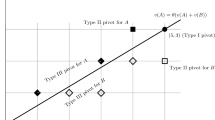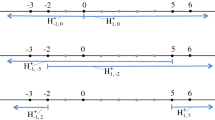Abstract
I examine a model of majority rule in which alternatives are described by two characteristics: (1) their position in a standard, left-right dimension, and (2) their position in a good-bad dimension, over which voters have identical preferences. I show that when voters’ preferences are single-peaked and concave over the first dimension, majority rule is transitive, and the majority’s preferences are identical to the median voter’s. Thus, Black’s (The theory of committees and elections, 1958) theorem extends to such a “one and a half” dimensional framework. Meanwhile, another well-known result of majority rule, Downs’ (An economic theory of democracy, 1957) electoral competition model, does not extend to the framework. The condition that preferences can be represented in a one-and-a-half-dimensional framework is strictly weaker than the condition that preferences be single-peaked and symmetric. The condition is strictly stronger than the condition that preferences be order-restricted, as defined by Rothstein (Soc Choice Welf 7:331–342;1990).
Similar content being viewed by others
References
Alvarez M, Nagler J (1998) When politics and models collide: estimating models of multi-candidate elections. Am J Pol Sci 42:131–150
Ansolabehere S, Snyder JM, Jr. (2000) Valence politics and equilibrium in spatial election models. Pub Choice 103:327–336
Aragones E, Palfrey T (2002) Mixed equilibrium in a downsian model. J Econ Theory 103: 131–161
Aragones E, Palfrey T (2005) Electoral competition between two candidates of different quality: the effects of candidate ideology and private information. In: Austen-Smith D, Duggan J (eds) Social choice and strategic decisions: essays in Honor of Jeffey S Banks. Springer, Berlin Heiderberg Neywork, pp 93–112
Austen-Smith D (1987) Interest groups, campaign contributions, and pluralistic voting. Pub Choice 54:123–137
Austen-Smith D, Banks J (1999) Positive political theory I: collective preference. University of Michigan Press, Ann Arbor
Banks J, Sundaram RK (1993) Moral hazard and adverse selection in a model of repeated elections. In: Barnett WA, Hinich MJ, Schofield NJ (eds) Political economy: institutions, competition, and representation. Cambridge University Press, Cambridge
Berger MM, Munger MC, Potthoff RF (2000) The Downsian model predicts divergence. J Theorl Polit 12:228–240
Bernhardt MD, Ingberman DE (1985) Candidate reputations and the ‘Incumbency Effect’. J Pub Econ 27:47–67
Black D (1958) The theory of committees and elections. Cambridge University Press, London
Butler D, Stokes D (1969) Political change in Britain. St. Martin’s Press, New York
Calvert RL (1985) Robustness of the multidimensional voting model: candidate motivations, uncertainty, and convergence. Am J Pol Sci 29:69–95
Cameron CM, Enelow JM (1992) Assymetric policy effects, campaign contributions, and spatial theory of elections. Math Comput Model 16:117–132
Cukierman A (1991) Asymmetric information and the electoral momentum of public opinion polls. Pub Choice 70:181–213
Denzau AT, Parks RP (1975) The continuity of majority-rule equilibrium. Econometrica 43: 853–866
Denzau AT, Parks RP (1983) Existence of voting-market equilibria. J Econ Theory 30:243–65
Downs A (1957) An economic theory of democracy. Harper & Row, New York
Dunz K (1989) Some comments on majority rule equilibria in local public good economies. J Econ Theory 47:228–234
Enelow JM, Endersby JW, Munger MC (1993) A revised probabilistic spatial model of elections: theory and evidence. In: Grofman B (eds) Information, participation, and choice: an economic theory of democracy in perspective. The University of Michigan Press, Ann Arbor
Enelow JM, Hinich MJ (1981) A new approach to voter uncertainty in the downsian model. Am J Pol Science 25:483–493
Enelow JM, Hinich MJ (1982) Nonspatial candidate characteristics and electoral competition. J Polit 44:115–130
Enelow JM, Hinich MJ (1984) The spatial theory of voting: an introduction. Cambridge University Press, New York
Fiorina M (1977) Representives, roll-Calls, and constituencies. Lexington Books, Lexington
Fiorina M (1981) Retrospective voting in American national elections. Yale University Press, New Haven
Gans JS, Smart M (1996) Majority voting with single-crossing preferences. J Pub Econ 59: 219–237
Gersbach H (1995) Competing for donors. Alfred-Weber-Institute, Heidelberg
Groseclose T (2001a) A model of candidate location when one candidate has a valence advantage. Am J Pol Sci 45:862–886
Groseclose T (2001b) A Model of candidate location when one candidate has a Valence advantage – extended version. http://www.polisci.ucla.edu/faculty/groseclose/Working.Papers/Model.of.Candidate.Extended.Vers.pdf
Harrington JE Jr, Hess GD (1996) A spatial theory of positive and negative campaigning. Games Econ Behav 17:209–229
Heckman JJ, Snyder JM Jr (1997) Linear probability models of the demand for attibutes with an empirical application to estimating the preferences of legislators. RAND J Econ 28:S142–S189
Hinich MJ, Munger MC (1989) Political investment, voter perceptions, and candidate strategy: an equilibrium spatial analysis. In: Ordeshook PC (eds) Models of strategic choice in politics. University of Michigan Press, Ann Arbor
Hinich MJ, Munger MC (1994) Ideology and the theory of political choice. University of Michigan Press, Ann Arbor
Ingbergman DE (1992) Incumbant reputations and ideological campaign contributions in spatial competition. Math Comput Model 16:147–169
Kramer GH (1971) On a class of equilibrium conditions for majority rule. Econometrica 41: 285–297
Londregan J (2000) Legislative institutions and ideology in chile. Cambridge University Press, New York
Londregan J, Romer T (1993) Polarization, incumbency, and the personal vote. In: Barnett WA, Hinich MJ, Schofield NJ (eds) Political Economy: institutions, competition, and representation. Cambridge University Press, New York
McCarty NM, Poole KT (1995) An empirical analysis of executive and legislative bargaining from 1961–1986. J Law Econ Org 12:282–312
Nechyba TJ (2003a) School finance, spatial income segregation and the nature of communities. J Urb Econ 54:61–88
Nechyba TJ (2003b) Centralization, fiscal federalism and private school attendance. Int Econ Rev 44:179–204
Nechyba TJ (2000) Mobility, targeting and private school vouchers. Am Econ Rev 90:130–46
Nechyba TJ (1999) School finance induced migration patterns: the impact of private school vouchers. J Pub Econ Theory 1:5–50
Nechyba TJ (1997a) Local property and state income taxes: the role of interjurisdictional competition and collusion. J Pol Economy 105:351–384
Nechyba TJ (1997b) Existence of equilibrium and stratification in local and hierarchical public Good Economies with property taxes and voting. Econ Theory 10:277–304
Ordeshook PC (1986) Game theory and political theory: an introduction. Cambridge University Press, New York
Plott CP (1967) A notion of equilibrium under majority rule. Am Econ Rev 57:787–806
Poole KT, Rosenthal H (1997) Congress: a political-economic history of roll call voting. Oxford University Press, New York
Rogoff K (1990) Equilibrium political budget cycles. Am Econ Rev 80:21–396
Rogoff K, Sibert A (1988) Elections and macroeconomic policy cycles. Rev Econ Stud 55:1–16
Rothstein P (1990) Order-restricted preferences and majority rule. Soc Choice Welf 7:331–342
Rothstein P (1991) Representative voter theorems. Pub Choice 72:193–212
Saari DG (1999) The Geometry of Black’s Single Peakedness and Related Conditions. J Math Econ 32:429–56
Schofield NJ (1983) Generic instability of majority rule. Rev Econ Stud 50:696–705
Schofield NJ (2005) A valence model of political competition in britain: 1992–1997. Electoral Stud 24:347–370
Schofield NJ (2005) Divergence in the spatial stochastic model of voting. Unpublished manuscript. Washington University in St. Louis
Schofield NJ, Martin A, Quinn K, Whitford A (1998) Multiparty electoral competitions in the Netherlands and Germany: a model based on multinomial probit. Pub Choice 97:257–293
Schofield NJ, Sened I (2005) Multiparty competition in Israel: 1988–1996. Br J Pol Sci 35: 635–663
Schofield NJ, Sened I, Nixon D (1998) Nash equilibrium in multiparty competition with stochastic voters. Ann Op Res 84:3–27
Sen A (1966) A possibility theorem on majority decisions. Econometrica 34:491–499
Sen A (1970) Collective choice and social welfare. Holden-Day Inc., San Francisco
Stokes D (1992) Valence politics. In: Kavanagh D (eds) Electoral politics. Clarendon Press, Oxford, pp 141–164
Author information
Authors and Affiliations
Corresponding author
Rights and permissions
About this article
Cite this article
Groseclose, T. ‘One and a Half Dimensional’ Preferences and Majority Rule. Soc Choice Welfare 28, 321–335 (2007). https://doi.org/10.1007/s00355-006-0166-3
Received:
Accepted:
Published:
Issue Date:
DOI: https://doi.org/10.1007/s00355-006-0166-3




